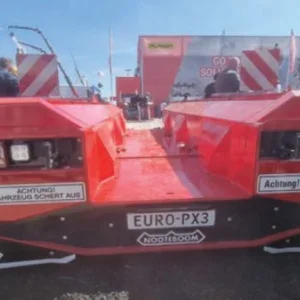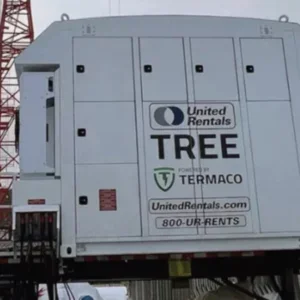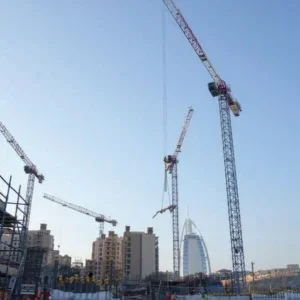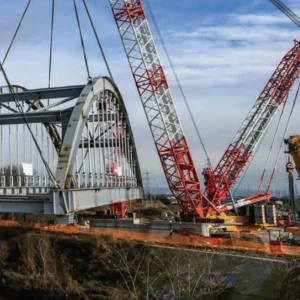Five large loader cranes shown at Italy’s SAIE exhibition in October are more likely to work like mobile cranes, raising loads on European construction sites, than offloading cargo from the back of a truck.
Over the last few years, the most popular all terrain capacity class has crept upward, from perhaps 30t to perhaps 50t. Some loader crane size classes have also followed this trend and migrated to higher capacities too: 50tm loader cranes are now much more common than they used to be. But above this size range a gap has opened up for large loaders mounting on four-axle commercial trucks whose job extends to delivering materials to first and second storeys of buildings, or other general lifting beyond loading and unloading transported goods.
“The entry-level mobile crane today is 50t capacity, which is more or less the 110tm-class 1500 (Fassi’s largest). If we go back 10 years, our biggest was the F1000, and the smallest mobile crane was 25t. So they have grown, and we have grown, one after another,” Fassi managing director Giovanni Fassi told Cranes Today at the show. He estimates that 1,500 units of these large loader cranes are sold per year.
Loader cranes are claimed to be less expensive than truck cranes, partly because they can be mounted to mass-produced commercial truck chassis via a custom-made subframe. In some European countries such as Italy and the UK, commercial trucks have a faster maximum speed limit (80km/hr in Italy) than purpose-built mobile cranes.
According to Giancarlo Perego, managing director of loader crane brands Fratelli Ferrari and Amco Veba, some buyers—including crane rental companies—are choosing a heavy loader over a secondhand mobile crane.
At least five new loader cranes above 80tm capacity, roughly equivalent to the capacity of a 30t-40t capacity truck crane, were on show. Most were new models, but the manufacturers were at different stages of readiness. Hiab’s 1055 is already in series production; Fassi’s 950AXP will begin series-production in March 2008. Ferrari’s 990 has been in series production for six months, and 15 units have been sold.
Large loaders share several features of conventional mobile cranes. All have a circular, motor-driven base whose slewing is unlimited by the length of the worm-gear shaft common on smaller cranes. Most are run not by paddles on a hydraulic valve block, but by a computer system. Four of the models implement the increasingly-common double-link system. On these cranes, the hydraulic rams that extend to raise up the crane do not push on the boom, but instead on a pivoting link-bar. This arrangement allows the crane to raise the second boom section beyond the horizontal, compensating for boom deflection when the crane is loaded, and also allowing for greater extension when headroom is limited.
The two largest cranes, the 200tm-class Cormach 225000E and the 100tm Effer 1355, share another important design detail with traditional truck cranes: a standard subframe. Normally, loader crane dealers custom-fit a frame of steel bar on top of a truck chassis to mount the crane. In contrast, these frames come with the crane. Both cranes need a special frame to hold a pair of outriggers that extend diagonally, instead of straight out from the truck frame. Effer has designed its frame to minimise the depth of the crane on the truck, saving valuable load space.
Because the diagonal outriggers brace the crane not only against side-to-side forces, but also front-to-back turning forces, these two cranes can lift the full rated load over a wider angle. If the Effer crane is mounted behind the cabin, its so-called CroSStab frame allows the crane to lift almost 100% capacity of loads over the cab, traditionally a loader crane weak point. This is needed if the crane would lift a man-basket, says Federico Lugli, Effer export area manager. It can also mount at the back of the truck chassis, and enable the crane to lift 100% load capacity over the back. The first Cormach unit, sold to Italian machinery mover Quaranta for installing steelwork, bridge cranes, concrete and industrial equipment, mounts at the rear. Quaranta will take delivery by the end of the year, according to Giulio de Luca.
The Fassi F950AXP is Fassi’s fourth-largest loader crane, and is based on the existing 800A model, but has a higher lifting capacity to fill the gap between the 800 and 1100. The crane features all of the company’s recent Evolution upgrades as standard, including a Danfoss D900 digital hydraulic valve-block that shares oil between several axes of motion. It also features the XP extra-power device that increases lifting capacity at the expense of speed. The crane is Fassi’s first to use SSAB Weldox 1030 steel in the telescoping boom sections and outer boom, Giovanni Fassi says.
The 100tm Effer 1355 is a new crane shown as part of a new project, the standardised CroSStab subframe. The 1355 will be available, only with the special subframe, by mid-2008, according to Lugli. A smaller model, the 1155, will come out at the end of 2008. It will feature a maximum of nine boom extensions and a jib with up to six extensions. Outreach had not been released by press date.
The Hiab 1055 is the Swedish company’s largest, and is probably one of the largest to fit on a four-axle commercial truck, leaving a payload of approximately 5t, says Andrea Perone of Hiab Italy. “In Italy the requirement for these kinds of cranes is increasing, especially for height,” he says. “With a basket, these cranes can do maintenance jobs that avoid the need for installing scaffolding,” which is more expensive, he says.
The other end of the scale
Even if they are far beneath the loader mainstream of a capacity class of 20tm, the smallest loader cranes (around 10tm) are still worth the time and effort of innovation, if new launches at SAIE were anything to go by. Size is particularly important at this scale because the cranes need to be light to fit on a small, two-axle 3.5t gvw truck.
At the show, Palfinger showed a new range of loader cranes, High Performance, in its Compact class (under 4tm capacity) and its 8tm-12tm class. The High Performance crane series, which will ultimately replace cranes in the previous Performance series, have new-look controls, a new design method and slightly improved load charts. The control system, now retro-illuminated, has soft plastic levers in a new plastic and steel sheet case. The electronic control system includes a digital hour counter, and can calculate total hours of operation, service hours and work hours per day. Stabiliser rams are now mounted with reflectors and 10,000hr white LEDs, which can be wired into the truck’s electrical system to flash in sequence. (A new electronic control system is coming next year). Boom system and cylinders feature plastic wear pads (now in blue, instead of the previous green).
Palfinger High Performance cranes have nearly the same deadweight, but have almost 10% more lifting moment, says Gerald Pschernig, head of Palfinger’s crane division. “This is not only because we are running at a higher oil pressure,” he tells Cranes Today, “but there are also structural changes in the main components.” That includes using high-tensile steel (such as STE 690 and 1890) and changed production technologies, with new robots and new welding processes.
In the Compact class were three redesigned compact cranes under 4tm, the 2.5tm PK 2900, 3.1tm PK 3400 and 3.9tm PK 4200. The cranes feature a redeveloped control valve that is said to reduce pressure peaks to improve service life and a reduced deadweight. The two larger models have a hydraulic outreach up to 10m (the PK 3400 C, with four extensions, can lift 220kg; PK 4200 C lifts 300kg). The PK4200, with only two extensions, weighs 521kg.
In total, there were 11 High Performance models as of late October. Nine were launched at the show: the PK 8501, PK 8501-K (a new design variety with short first boom to increase lifting performance and cut down on weight), PK 8502, PK 9001-EH (packed in kit form with overload indicator, remote control, installed oil cooler and additional tank), PK 11001, PK 11001-K, PK 11002, PK 12001-EH. Two more, the PK 9002 EH and PK 12002 EH, were not present. A total of 80 models are due to be launched in the range over the next three years. Series production starts at the beginning of next year.
Out of environmental concerns, Palfinger is changing to Chrome 63, which does not contain the toxic element mercury. Spiral hose covers have been brought into smaller ranges. The 8.5tm 8502 and 11tm 11002 are fitted with linkage bars on the lower extensions to extend the second boom upwards 15°.
Palfinger was not the only builder to launch a series of small loaders.
Benelligru is launching its SL – ‘super light’ series of seven models of loaders with capacities of 3tm, 5tm, 7tm and 11tm. These models rely on hydraulically-extending jib sections for outreach. Either two or three extensions are available (only two extensions are available on the smallest model, the 3200/2 SL). The largest, the 11200/3 SL, weighs 1,325kg and can lift 950kg to a maximum horizontal outreach of 8.2m. It has also launched the Gru 1510/1S1, with a single extension on the second boom, and a single extension on the jib, for a small truck. The crane is 1.5m wide and weighs 300kg.
Amco Veba’s 3tm 103 has a similar lifting capacity to its predecessor, but costs 30% less, says Giancarlo Perego. The crane was launched at Bauma after a design study examined ways to cut costs. The crane has been so popular that the company is currently designing a 5tm, 7tm and 10tm model to launch next year.
“We were thinking we would design it for the growing economies of the world, who would buy a used crane instead of new because of price,” Perego tells Cranes Today. “We achieved that; in fact we achieved a place in a lower part of the market in the mature economies dominated by competitors such as Bonfiglioli and Benelligru.”
The design saves up to 40% of the welding normally required, Perego says. The crane’s base and column at least are made of square tube steel sections that arrive pre-formed by a Finland-based supplier whose name Perego declines to say. A base mounting bracket adjusts in width to fit many types of subframes.
The new Italian loader crane manufacturer KLM, set up in 2005, has enlarged its range of small loader cranes with its largest model yet, the 11tm KG 11.0. The company, Terex-Atlas’s dealer in the UK, also supplies its range of loaders to Terex for re-badging. It claims its loaders are the only ones in the industry whose first and second booms extend not only vertically, but beyond the vertical in a negative angle. This feature is useful for loading close to the crane, export manager Benoit Degeuse tells Cranes Today. When erected, it can lift loads as close as 1m from the centre of rotation. Unlike some other loader cranes, these models have non-telescoping primary and secondary booms, and a hydraulic extending jib with three extensions. The Set 11.0 S3 can lift 800kg to maximum horizontal outreach of 10m and weighs 1480kg.
KLM has begun an export marketing agreement with southern Italian crane manufacturer Frigenti Cranes. The company is marketing its range of small cranes (2tm-5tm capacity) with grab or claw for material handling on a 3.5t gvw truck. The range was developed three years ago, and has so far sold about 10 units.
PM has fitted new electronic Power Tronic Compact controls to the 10, 14, 16 and 19P models. The new CANbus-based control system, whose plastic case and display panel resembles that of Palfinger, is self-contained and attaches to the crane with quick connectors, according to PM product development manager Giuseppe Ceraolo. New generation of antennas from remote control suppliers Scanreco and Hetronic also fit into the box.
Effer 1355 loader crane mounted on CroSStab diagonal outrigger subframe Effer 1355 loader crane mounted on CroSStab diagonal outrigger subframe Cormach 225000 E loader crane, shown without subframe Cormach 225000 E loader crane, shown without subframe Hiab 1055 loader crane, shown with jib Hiab 1055, shown with jib Fassi F950 loader crane Fassi F950 loader crane Palfinger PK 85002 High Performance at SAIE Palfinger PK 85002 High Performance at SAIE KLM KG 11.0 loader crane at SAIE KLM KG 11.0 loader crane at SAIE Amco Veba 103 loader crane at SAIE Amco Veba 103 loader crane at SAIE Frigenti material handling crane Frigenti material handling crane Autogru PM’s new control console Autogru PM’s new control console Not only the big cranes had standardised subframes. Autogru PM showed a 3523 crane mounted on the Daily Iveco 4×4 light truck intended for the construction sector. PM mounted on Iveco Daily 4×4 truck






